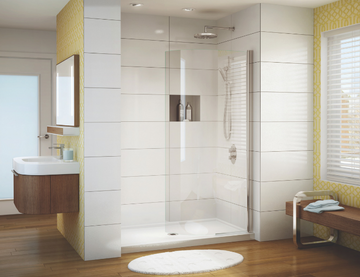Whether you're replacing an old bathroom vanity or starting fresh, the installation process doesn't need to be daunting. For a seamless installation, we recommend consulting a professional. But for the ambitious among us, this step-by-step guide will teach you how to install a bathroom vanity. Remember, procedures may vary depending on your vanity style.
What You Will Need
Adjustable wrench
Pliers
Bucket
Chisel
Drill
Stud finder
Pencil
Utility knife
Caulk
Hole saw
Screws
Leveling bar
Tapered shims (optional)
Adhesive
Plumber's putty
Follow the first five steps if you are removing an old vanity before installing a new one. However, if you are starting from scratch, skip to step 5.
Step 1: Turn Off and Disconnect the Water Supply
Cut your water supply by using the shutoff valves underneath the sink. To release the water pressure off the lines, open your sink faucet and let the water run until it turns to a slow drip. Use an adjustable wrench to disconnect the water supply tubes, keeping a bucket on hand to catch any excess water.
Step 2: Disconnect the Sink
Use pliers to loosen the P-trap (the U-shaped part of the drainpipe) and disconnect it from the sink’s vertical drainpipe, using a bucket to catch any excess water.
Step 3: Remove the Vanity Top
Use a utility knife to cut the caulk along the backsplash. If your vanity top is also secured with screws and glue, use a drill and chisel to separate it from the base. Then carefully remove the top of the vanity.
Step 4: Remove the Vanity Base
To remove the vanity base, take out any screws with your drill at the back of the base and pull the vanity out. Repair any damage to the walls.
Step 5: Mark the Wall for the New Vanity
Review manufacturer's instructions for specific steps, then start by marking the wall with an outline of your new vanity, accounting for height, width, and placement. Use a stud finder to locate and mark the studs within the outlined area for vanity attachment. Keep in mind that most studs are 16" – 24" apart.
Step 6: Prepare the Vanity Back
Many vanities have openings in the back for plumbing. If yours doesn't, you'll need to cut the holes yourself. Use the wall outline to measure from the base to the pipes. Mark these measurements on your vanity's back. Then, use a hole saw to cut holes for the drain and supply pipes.
Step 7: Position and Level the Vanity
Use your outline on the wall to set the vanity in place. With a level, check that the top of the base sits evenly at all four corners. Make any required adjustments with tapered shims.
Step 8: Secure the Vanity Base
Use a drill to screw the back of the vanity into the studs. For holes that are not in line with studs, use anchors that match your wall type.
Step 9: Install Faucet, Drain, and Sink
First, assemble the faucet and drain – making sure to place the plastic gasket under the faucet and handles. Feed the faucet and handles into the proper holes. Under the sink install the washers and nuts to secure them into place. Apply a bead of plumber's putty under the lip of the drain and push it into place. Underneath the sink, tighten the mounting bracket. Wipe away any excess putty. If your sink is not already attached to the countertop, install it now. Each sink type is installed differently, so we recommend referring to the manufacturer's instructions.
Step 10: Secure the Vanity Top
Apply a thin bead of adhesive to the top of the vanity base. Then carefully set the vanity top in place, taking care to align the plumbing. Also if the vanity top overhangs the bottom slightly, make sure that it is even on all sides. Press down firmly. If your vanity comes with a separate backsplash, apply a bead of silicone caulk along the back of the piece and press it firmly against the wall. Place a bead of caulk between the backsplash and the wall, and between the bottom of the backsplash and the countertop. If you don't have a backsplash, apply a bead of caulk between the wall and the vanity top. Allow 24 hours to dry.
Step 11: Connect the Plumbing
Reattach the drain and water supply lines, wrapping plumber’s tape around the threaded sections to create a watertight seal.
Step 12: Test It Out
Turn on the water supply and run the water. Check for any signs of leaks and adjust accordingly.
Step 13: Attach Doors and Hardware
Use manufacturer’s instructions to assemble or connect any doors, drawers, and hardware.
Now that you know how to install a bathroom vanity, sit back, relax, and enjoy your hard work!
Related Articles
Tags
- Acrylic
- Alcove Bathtubs
- Basic Types of Bathtubs
- basin waste
- Bath
- bath bombs
- bathroom
- bathroom cleaning
- bathroom decor
- bathroom design
- bathroom healthcare
- bathroom mirrors
- bathroom mould
- bathroom plants
- bathroom remodel
- bathroom renovation
- bathroom sink
- Bathroom Sink Overflow
- bathroomtips
- Bathtub Materials
- bathtubs
- Cast Iron
- Composite
- Copper
- Corner Bathtubs
- Drop-in bathtubs
- Faucet Grease
- Fiberglass
- Free-Standing Bathtubs
- High Pressure
- Plumber's Grease
- plumbing
- Porcelain-Enameled
- Rain Shower Heads
- shower
- shower bath
- shower faucet
- Showerhead
- sink plumbing in the bathroom
- sink waste
- Solid Surface
- Specialty Wood
- walk in shower
- Wet room




